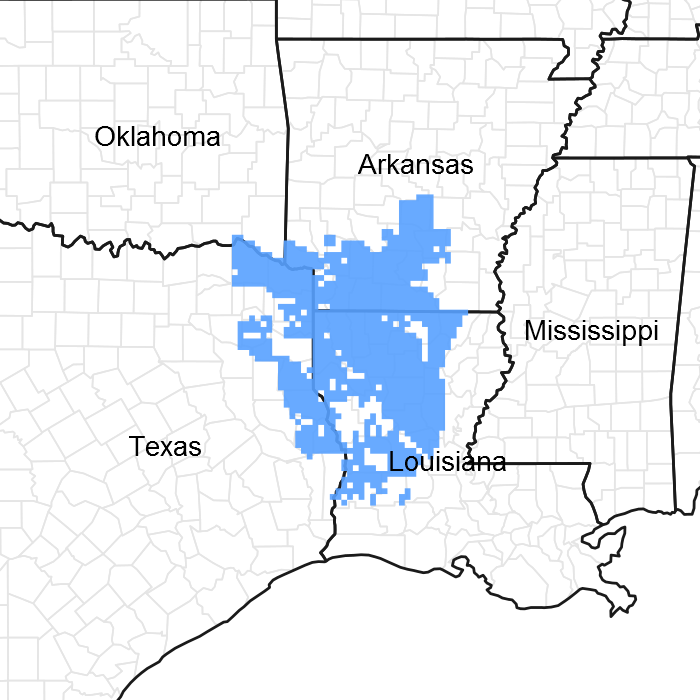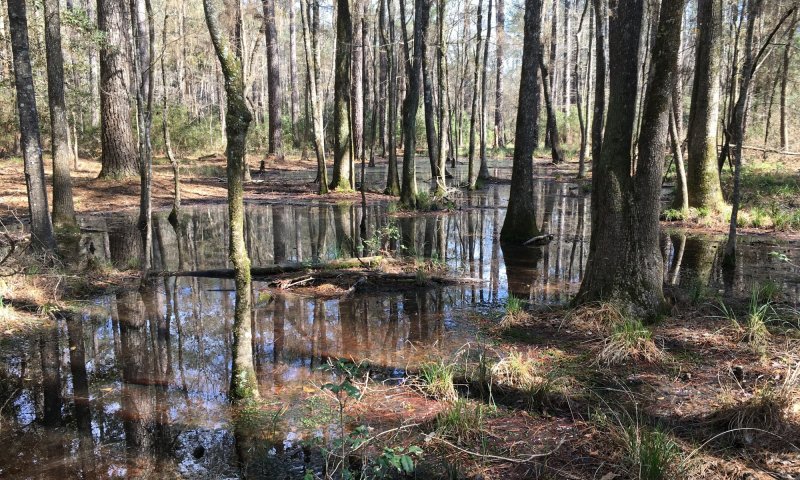

Natural Resources
Conservation Service
Ecological site F133BY012TX
Wet Terrace
Last updated: 9/21/2023
Accessed: 12/21/2025
General information
Provisional. A provisional ecological site description has undergone quality control and quality assurance review. It contains a working state and transition model and enough information to identify the ecological site.

Figure 1. Mapped extent
Areas shown in blue indicate the maximum mapped extent of this ecological site. Other ecological sites likely occur within the highlighted areas. It is also possible for this ecological site to occur outside of highlighted areas if detailed soil survey has not been completed or recently updated.
MLRA notes
Major Land Resource Area (MLRA): 133B–Western Coastal Plain
Major Land Resource Area (MLRA) 133B, Western Coastal Plain is in eastern Texas, western Louisiana, and the southwest corner of Arkansas. The area is dominated by coniferous forest covering 45,450 square miles (29,088,000 acres). The region is a hugely diverse transition zone between the eastern deciduous forests and the central grasslands to the west.
Classification relationships
USDA-Natural Resources Conservation Service, 2006.
-Major Land Resource Area (MLRA) 133B
Ecological site concept
The Wet Terrace site has very deep soils on terrace landforms. They are positioned higher than bottomlands and lower that uplands. This landscape position coupled with their slowly permeable, poorly drained soils form their unique plant community.
Associated sites
| F133BY017TX |
Loamy Bottomland Sites are on a lower bottom landscape and flood regularly. |
|---|---|
| F133BY018TX |
Clayey Bottomland Sites are on a lower bottom landscape and flood regularly. |
| F133BY001TX |
Depression Sites are located in depressions of uplands and terraces. Sites are typically wetter and are ponded for portions of the year. |
| F133BY002TX |
Seasonally Wet Upland Sites are on a higher landscape on the uplands. |
| F133BY003TX |
Loamy Over Clayey Upland Sites are on uplands and have clay textures throughout their horizons. |
| F133BY004TX |
Loamy Claypan Upland Sites are on uplands and have an abrupt textural change from loam to clay. Sites are sometime shallow to bedrock. |
| F133BY005TX |
Loamy Upland Sites are on uplands and have loamy textured soil throughout their profile. |
| F133BY011TX |
Deep Sandy Terrace Sites are on a similar landscape position by are characterized by deep sands with rapid drainage. |
| F133BY013TX |
Terrace Sites are on a similar terrace position but have more developed drainage patterns. Sites are not as wet. |
| F133BY014TX |
Creek Bottomland Sites are located in a bottomland position and flood regularly. |
| F133BY015TX |
Swamp Sites are on the lowest part of the landscape and are semi-permanently ponded. |
| F133BY016TX |
Sandy Bottomland Sites are on a lower bottom landscape and flood regularly. |
Similar sites
| F133BY001TX |
Depression Sites are located on depression of uplands and terraces. Sites are ponded for portions of the year and have wetter associated plants. |
|---|---|
| F133BY002TX |
Seasonally Wet Upland Sites are on a higher upland landscape. |
Table 1. Dominant plant species
| Tree |
(1) Quercus nigra |
|---|---|
| Shrub |
Not specified |
| Herbaceous |
Not specified |
Click on box and path labels to scroll to the respective text.
Ecosystem states
| T1A | - | Clearcut, site preparation, tree planting |
|---|---|---|
| T1B | - | Clearcut, grass/crop planting |
| R2A | - | Gap-phase regeneration or clearcut with tree planting |
| T2A | - | Clearcut, grass/crop planting |
| R3A | - | Tree planting, mature overstory establishment |
| T3A | - | Clearcut, site preparation, tree planting |
